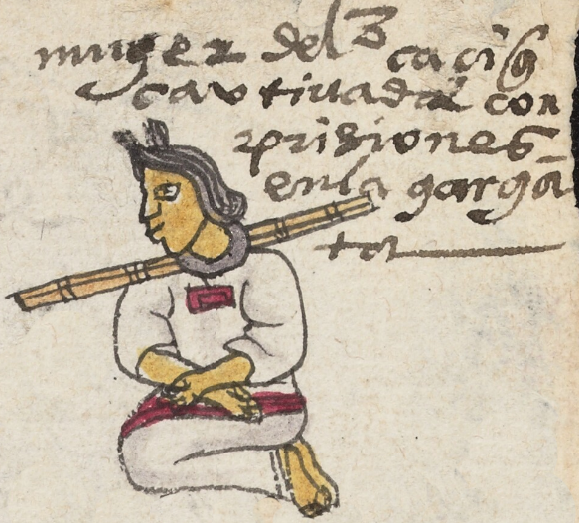cuauhcozcatl (Mdz66r)
This iconographic element provides a comparison to our glyphs for cozcatl (necklaces). This cuauhcozcatl (wooden neck ring) has nothing to do with jewelry. The ring was attached to poles (here, segmented reeds like carrizo or bamboo) and used to control an enslaved person. In this case the enslaved person is a woman, which is clear from the way she wears here hair, with two points at the top, and we can see the rectangle over her chest, which was a prominent feature of the blouse (huipilli) of that time. Her skin is yellowish. A stick (tlacotl) is attached to the ring around her neck. The neck ring is a purplish gray, as his her hair. Her clothing is white with red accents. The context image shows the typical female sitting pattern, where her legs are underneath her. She also wears a skirt. Her feet are bare, and her hands are crossed over her lap. She is in profile looking to our left.
Stephanie Wood
The contextualizing image shows the dejected situation of the captive woman, who was the wife of a cacique who, in turn, was probably an enemy. The gloss explains that she has a type of stocks around her neck. The stick attached to her throat ring actually appears to be two osier twigs tied together at multiple points. The use of cuauh- here seems to point to the wooden material for the neck rink, although the color of wood in the Codex Mendoza is usually a terracotta orange. Interestingly, the word for slave is tlacotli, revealing an obvious relationship between the confining dimension of a neck ring connected to the osier twigs made into a rod, tlacotl, and slavery.
A market scene from the Códice Durán, published as part of a vignette created by Marc Thouvenot, includes what seem to be two enslaved people, one man and one woman. See: https://vignettes.sup-infor.com/imagen/DU_02_300v_a.
Stephanie Wood
prisiones en la garganta
prisiones en la garganta
Stephanie Wood
c. 1541, or by 1553 at the latest
Stephanie Wood
prisones, collares, esclavitud, confinammiento, encierro
cuauhcozca(tl), wooden neck ring, https://nahuatl.wired-humanities.org/content/cuauhcozcatl
cozca(tl), necklace, https://nahuatl.wired-humanities.org/content/cozcatl
tlaco(tl), rod of osier twigs, https://nahuatl.wired-humanities.org/content/tlacotl
tlaco(tli), enslaved person, https://nahuatl.wired-humanities.org/content/tlacotli
cihua(tl), woman, https://nahuatl.wired-humanities.org/content/cihuatl
cuauhcoyoc(tli)>, stocks, https://nahuatl.wired-humanities.org/content/cuauhcoyoctli
prisiones en la garganta
Codex Mendoza, folio 66 recto, https://digital.bodleian.ox.ac.uk/objects/2fea788e-2aa2-4f08-b6d9-648c00..., image 142 of 188.
Original manuscript is held by the Bodleian Libraries, University of Oxford, MS. Arch. Selden. A. 1; used here with the UK Creative Commons, “Attribution-NonCommercial-ShareAlike 3.0 License” (CC-BY-NC-SA 3.0)







